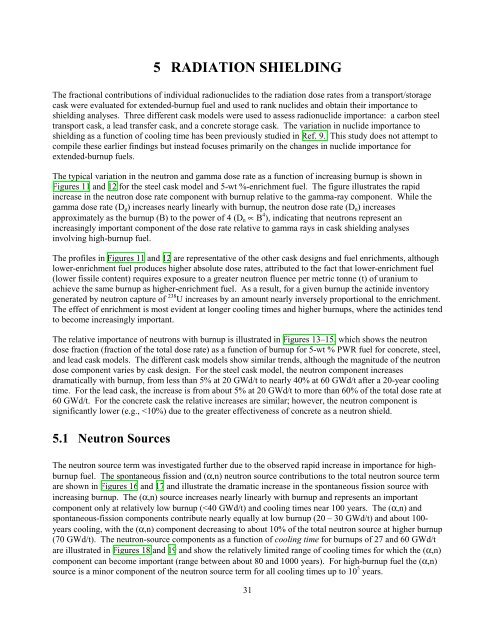nureg/cr-6700 - Oak Ridge National Laboratory
nureg/cr-6700 - Oak Ridge National Laboratory
nureg/cr-6700 - Oak Ridge National Laboratory
You also want an ePaper? Increase the reach of your titles
YUMPU automatically turns print PDFs into web optimized ePapers that Google loves.
Section 5<br />
Radiation Shielding<br />
5 RADIATION SHIELDING<br />
The fractional contributions of individual radionuclides to the radiation dose rates from a transport/storage<br />
cask were evaluated for extended-burnup fuel and used to rank nuclides and obtain their importance to<br />
shielding analyses. Three different cask models were used to assess radionuclide importance: a carbon steel<br />
transport cask, a lead transfer cask, and a con<strong>cr</strong>ete storage cask. The variation in nuclide importance to<br />
shielding as a function of cooling time has been previously studied in Ref. 9. This study does not attempt to<br />
compile these earlier findings but instead focuses primarily on the changes in nuclide importance for<br />
extended-burnup fuels.<br />
The typical variation in the neutron and gamma dose rate as a function of in<strong>cr</strong>easing burnup is shown in<br />
Figures 11 and 12 for the steel cask model and 5-wt %-enrichment fuel. The figure illustrates the rapid<br />
in<strong>cr</strong>ease in the neutron dose rate component with burnup relative to the gamma-ray component. While the<br />
gamma dose rate (D g ) in<strong>cr</strong>eases nearly linearly with burnup, the neutron dose rate (D n ) in<strong>cr</strong>eases<br />
approximately as the burnup (B) to the power of 4 (D n ∝ B 4 ), indicating that neutrons represent an<br />
in<strong>cr</strong>easingly important component of the dose rate relative to gamma rays in cask shielding analyses<br />
involving high-burnup fuel.<br />
The profiles in Figures 11 and 12 are representative of the other cask designs and fuel enrichments, although<br />
lower-enrichment fuel produces higher absolute dose rates, attributed to the fact that lower-enrichment fuel<br />
(lower fissile content) requires exposure to a greater neutron fluence per metric tonne (t) of uranium to<br />
achieve the same burnup as higher-enrichment fuel. As a result, for a given burnup the actinide inventory<br />
generated by neutron capture of 238 U in<strong>cr</strong>eases by an amount nearly inversely proportional to the enrichment.<br />
The effect of enrichment is most evident at longer cooling times and higher burnups, where the actinides tend<br />
to become in<strong>cr</strong>easingly important.<br />
The relative importance of neutrons with burnup is illustrated in Figures 13–15, which shows the neutron<br />
dose fraction (fraction of the total dose rate) as a function of burnup for 5-wt % PWR fuel for con<strong>cr</strong>ete, steel,<br />
and lead cask models. The different cask models show similar trends, although the magnitude of the neutron<br />
dose component varies by cask design. For the steel cask model, the neutron component in<strong>cr</strong>eases<br />
dramatically with burnup, from less than 5% at 20 GWd/t to nearly 40% at 60 GWd/t after a 20-year cooling<br />
time. For the lead cask, the in<strong>cr</strong>ease is from about 5% at 20 GWd/t to more than 60% of the total dose rate at<br />
60 GWd/t. For the con<strong>cr</strong>ete cask the relative in<strong>cr</strong>eases are similar; however, the neutron component is<br />
significantly lower (e.g.,

















